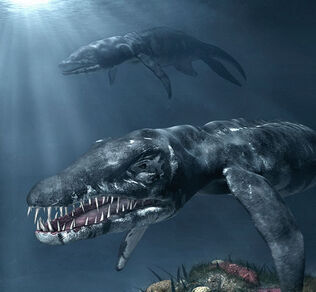No edit summary |
No edit summary |
||
| Line 14: | Line 14: | ||
Pliosaur remains excavated from Kimmeridge Clay Formation of England indicate a much larger taxon, possibly up to 15 metres (49.2 feet long), existed, however they have not been identified as belonging to ''Liopleurodon''. A mandible on display in the Oxford University Museum of Natural History estimated over 3 metres (preserved 2.875m) was at one time classified as ''Liopleurodon macromerus''. When the mandible was described, it was originally assigned to ''Stretosaurus'' (as ''Stretosaurus macromerus''). The genus ''Stretosaurus'' later became a junior synonym of ''Liopleurodon''. However, it has been re-classified as ''Pliosaurus macromerus''. |
Pliosaur remains excavated from Kimmeridge Clay Formation of England indicate a much larger taxon, possibly up to 15 metres (49.2 feet long), existed, however they have not been identified as belonging to ''Liopleurodon''. A mandible on display in the Oxford University Museum of Natural History estimated over 3 metres (preserved 2.875m) was at one time classified as ''Liopleurodon macromerus''. When the mandible was described, it was originally assigned to ''Stretosaurus'' (as ''Stretosaurus macromerus''). The genus ''Stretosaurus'' later became a junior synonym of ''Liopleurodon''. However, it has been re-classified as ''Pliosaurus macromerus''. |
||
| − | The discovery of a very large pliosaur was announced in 2002, from Mexico, nicknamed the 'Monster of Aramberri'. A cautious estimate placed this juvenile at about 15 metres (49.2 ft) long. It was widely reported belonging to ''Liopleurodon'', however no taxonomic conclusions could be made due to poor preservation and fact that the remains were of a partial vertebral column (non-diagnostic). The specimen was dated to the Kimmeridgian age of the La Caja Formation. |
+ | The discovery of a very large pliosaur was announced in 2002, from Mexico, nicknamed the 'Monster of Aramberri'. A cautious estimate placed this juvenile at about 15 metres (49.2 ft) long. It was widely reported belonging to ''Liopleurodon'', however no taxonomic conclusions could be made due to poor preservation and fact that the remains were of a partial vertebral column (non-diagnostic). The specimen was dated to the Kimmeridgian age of the La Caja Formation. but it has now been identified as a junior liopleuroodn meaning an adult would be possibly up ot 25m long and 150t in weight it was the largest predadtor ever the same length as spinosaurus but over 3 times its weight each tooth would be oever a foo long in an afult indixividula it also had a roar that sounded 200 decibels and had eys that |
==In The Media== |
==In The Media== |
||
Revision as of 11:37, 3 March 2010

An artists impression of Liopleurodon and an un-known Pliosaur cruising the ocean.
Liopleurodon is a large Pliosaurid from the Jurassic sea's of Europe. three species have been named. L. ferox, the Type species and L. pachydeirus lived during the Callovian stage of the Middle Jurassic Period (c. 160 to 155 mya), while the third, L. rossicus, lived during the Late Jurassic.
Size
Estimating the maximum size of Liopleurodon has become a controversial subject. The palaeontologist L. B. Tarlo derived that the total body length of a pliosaur (including Liopleurodon) can be estimated from skull length, in which the skull is approximately one seventh of the entire body. The largest known skull belongs to L. ferox (1.5 metres in length), and according to Tarlo's estimation, this individual would be about 11 m (38 ft) long. However, as with its relative Kronosaurus, there is some uncertainty as to whether Tarlo's estimates are correct.
Recent studies on pliosaurs have cast doubt on Tarlo's size estimates, and indicate that pliosaur skulls were about one-fifth of the total body length. Hence, the average size of the L. ferox would have ranged from 7 metres (23 ft) to 10 metres (33 ft) long.
Pliosaur remains excavated from Kimmeridge Clay Formation of England indicate a much larger taxon, possibly up to 15 metres (49.2 feet long), existed, however they have not been identified as belonging to Liopleurodon. A mandible on display in the Oxford University Museum of Natural History estimated over 3 metres (preserved 2.875m) was at one time classified as Liopleurodon macromerus. When the mandible was described, it was originally assigned to Stretosaurus (as Stretosaurus macromerus). The genus Stretosaurus later became a junior synonym of Liopleurodon. However, it has been re-classified as Pliosaurus macromerus.
The discovery of a very large pliosaur was announced in 2002, from Mexico, nicknamed the 'Monster of Aramberri'. A cautious estimate placed this juvenile at about 15 metres (49.2 ft) long. It was widely reported belonging to Liopleurodon, however no taxonomic conclusions could be made due to poor preservation and fact that the remains were of a partial vertebral column (non-diagnostic). The specimen was dated to the Kimmeridgian age of the La Caja Formation. but it has now been identified as a junior liopleuroodn meaning an adult would be possibly up ot 25m long and 150t in weight it was the largest predadtor ever the same length as spinosaurus but over 3 times its weight each tooth would be oever a foo long in an afult indixividula it also had a roar that sounded 200 decibels and had eys that
In The Media

Liopleurodon from WWD dueling with a Megalodon in a fictional fight. Note the Liopleurodon is probally in excess of 18m in this image.
Liopleurodon notably appeared in the BBC's Walking With Dinosaurs. However it was grossly oversized, it was said to be 25m long and 150t in weight. A possible exaplanation for this is the confusions regarding a 3m Pliosaur skull once thought to belong to Liopleurodon (see the Size section above). It also featured in the related series called Sea Monsters also by the BBC. This again showed Liopleurodon as the largest killer ever, and according to the shows website, it was an Omnivore. [1] While in reality it was an exclusive carnivore.